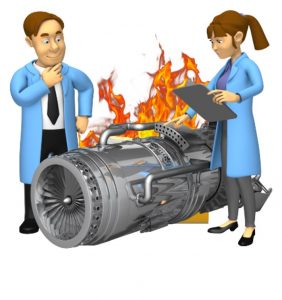Inventors are Not Created Equal
How to Recognize and Grow Different Types of Inventors
Innovators are often difficult to recognize. They don’t wear signs or fit a particular personality profile. Sometimes they quietly go through the day while drawing little attention to themselves and many times it seems they cannot stop talking about their ideas or inventions.
What often happens is inventors fall into different categories. These categories tend to define how the inventor and the company interact. While the majority of innovators are normal everyday employees who happen to have a good idea, you will find others tend to fit into specific categories with their own reasons for innovating.
Favored Inventors
 This type of innovator is favored by the innovation or intellectual property team. Most ideas they develop are fast tracked through the organization. Road blocks and hurdles seem to magically disappear when the Favored Inventor’s name is associated with an idea. They know the process and appear to seamlessly navigate the system.
This type of innovator is favored by the innovation or intellectual property team. Most ideas they develop are fast tracked through the organization. Road blocks and hurdles seem to magically disappear when the Favored Inventor’s name is associated with an idea. They know the process and appear to seamlessly navigate the system.
Favored Inventors generally do not need to be encouraged to develop more ideas. They are generally prolific inventors and will continue this trend unless they are actively discouraged from inventing.
The danger with Favored Inventors is others may view their treatment as unfair or advantaged over other inventors. These types of inventors may be viewed as not having to play by the rules.
In order to combat this perception, you need to make sure Favored Inventors are required to take the same steps as other inventors. They need to follow the established procedures with their inventions. Typically this is not a problem; they have been through the process many times and have developed their own system for navigating the innovation process.
![]()
Favored Inventors do not like changes in the system. They are typically comfortable with the current system as it exists. To keep from disrupting your Favored Inventors, any changes should be clearly communicated to these inventors well in advance of any implementation.
Special meetings, webinars, or face-to-face meetings should be used to communicate any changes and reasons for the changes to the current innovation program well in advance of any implementation.
![]()
Improve your innovation program by having Favored Inventors mentor others. Many times Favored Inventors are respected and influential among the employee base and potential innovators. Favored Inventors can be used to help encourage others to innovate and to help new innovators navigate the system. They can be one of your biggest advocates for your innovation program. If used correctly, they can be one of the best tools in changing the culture of your organization towards innovation. Of course this is dependent on individual personalities, however, you should actively encourage, assist, and compensate these innovators to help promote your innovation program and help other inventors.
![]() Favored Inventors can be used to help refine your innovation program. They have been through the process enough times to be familiar with the good and the bad of the program. Their advice and assistance can be extremely useful when contemplating or implementing structural changes. Another benefit of involving these innovators early in the process is they can become some of your most respected channels to communicate changes and their benefits.
Favored Inventors can be used to help refine your innovation program. They have been through the process enough times to be familiar with the good and the bad of the program. Their advice and assistance can be extremely useful when contemplating or implementing structural changes. Another benefit of involving these innovators early in the process is they can become some of your most respected channels to communicate changes and their benefits.
![]()
Most times Favored Inventors have received their status because the purpose of their innovation is to move the organization forward, however, you may find some Favored Inventors losing their focus and tending to become a Paperhanger. You should be on your guard to protect against this. If you think a Favored Inventor is losing their focus or becoming less effective you may want to dedicate resources to help bring them back on track. Typically this can be additional training on technologies or intellectual property issues.
Remember these are some of your best innovation resources in your organization. Don’t let a lack of investment be part of the cause of the decline of this resource.
Stealth Inventors
Stealth Inventors are the inventors who you tend to never see or hear, however, when you look at your records you see they have numerous patents and have rolled out multiple services. They tend to work around the system if you allow them to do so.

Often they show up at the innovation or intellectual property group with a fully formed idea which is about to be launched into the market and they need to get a patent filed immediately before the product is launched. They tend to recognize the protecting of ideas as just a single part of launching service or product.
![]() Get out of the way of Stealth Inventors. Find ways to assist in their launching of new products. Get involved with their process early. Make sure they don’t view the innovation program as a last minute requirement before the market launch. You may be able to use provisional patent applications to gain early commitment and involvement of these types of inventors.
Get out of the way of Stealth Inventors. Find ways to assist in their launching of new products. Get involved with their process early. Make sure they don’t view the innovation program as a last minute requirement before the market launch. You may be able to use provisional patent applications to gain early commitment and involvement of these types of inventors.
![]() You should try to find out if the Stealth Inventors have any future ideas. You will have to be proactive about asking the questions and getting disclosures for these ideas. Since they are not fully formed, the Stealth Inventor may not feel comfortable releasing them before their time. Oftentimes the Stealth Inventor sees you as part of their process to get a product or service into the market. Find ways to be part of their process – you will not be disappointed. These are some of the best innovators in your organization.
You should try to find out if the Stealth Inventors have any future ideas. You will have to be proactive about asking the questions and getting disclosures for these ideas. Since they are not fully formed, the Stealth Inventor may not feel comfortable releasing them before their time. Oftentimes the Stealth Inventor sees you as part of their process to get a product or service into the market. Find ways to be part of their process – you will not be disappointed. These are some of the best innovators in your organization.
Don’t be afraid of developing special policies and procedures to address these types of innovators. Don’t fall into the trap of thinking your program needs to be equal for all innovators or to treat all innovators the same. Proven innovators who have achieved real value for the organization should receive a disproportionate amount of your time and resources.
Busy Bee Inventors
  You may find employees in hot, dynamic, or growing market segments are too busy to participate in any type of innovation or intellectual property protection program. They are extremely busy moving the business forward and have little time for anything else. Unfortunately, these are exactly the innovators you would like to have participate in your program. They are on the cutting edge of your organization and technology. The question usually becomes – how?
You may find employees in hot, dynamic, or growing market segments are too busy to participate in any type of innovation or intellectual property protection program. They are extremely busy moving the business forward and have little time for anything else. Unfortunately, these are exactly the innovators you would like to have participate in your program. They are on the cutting edge of your organization and technology. The question usually becomes – how?
Busy Bee Inventors are one of the trickiest types to get to participate in your innovation or intellectual property protection program. In most cases, these are some of the best compensated employees. Their bonus plans are usually tied to actual implementation of real technologies or services. They are some of the hardest working employees and they put in some of the longest hours.
![]() To encourage Busy Bee Inventors to participate, you can tie innovation to future product/technology training for the inventors. The innovation program can bring in experts to provide training classes.
To encourage Busy Bee Inventors to participate, you can tie innovation to future product/technology training for the inventors. The innovation program can bring in experts to provide training classes.
After the training class the attendees are asked questions like – how can this be used in our business; what if our competitors did this, how would we react; what comes after this; what patents can we come up with surrounding this idea, etc. The Busy Bee Inventors should be encouraged to think of how the organization can use, compete against, expand, enhance, or prevent the technology or product. An emphasis should be placed on how the organization can achieve a unique position in the future market using the technology or product.
![]() Busy Bee Inventors should be encouraged and rewarded for input given within a certain time period after a training class or program. Also, the innovation team should proactively follow up with them to encourage participation.
Busy Bee Inventors should be encouraged and rewarded for input given within a certain time period after a training class or program. Also, the innovation team should proactively follow up with them to encourage participation.
Not only will this strategy encourage the Busy Bee Inventors to participate in the innovation program, it will also show the value the organization places on innovation. If implemented correctly, training on future technologies or products linked to innovation can be used to help change the culture of the organization.
Paperhangers
 In the patent world, there is a school of thought which has always mystified me. This school of thought seems to believe patents have value regardless of their quality. You may find attorneys, patent agents, patent examiners, inventors, etc., who seem to think in this quantity vs. quality manner. They are paperhangers. To them, the purpose of patents is to generate a plaque for the wall, allow a box to be checked, or to fulfill a quarterly goal.
In the patent world, there is a school of thought which has always mystified me. This school of thought seems to believe patents have value regardless of their quality. You may find attorneys, patent agents, patent examiners, inventors, etc., who seem to think in this quantity vs. quality manner. They are paperhangers. To them, the purpose of patents is to generate a plaque for the wall, allow a box to be checked, or to fulfill a quarterly goal.
I can somewhat understand the paperhanger goal for some specific inventors, especially new inventors without any patents. Being an inventor with a patent to your name provides some level of validation of your expertise. An argument can be made that a patent is similar to a certification, license, or pedigree. It tends to lend credibility.
As I have told many first time inventors when I inform them their first patent has been granted – “Doesn’t it feel like you are the scarecrow in the Wizard of Oz? You are suddenly smarter because someone gave you a piece of paper.â€
![]()
 Also, If you have a child or know a young person who desires to enter college to pursue an engineering or technical degree, it may be helpful if they can get a patent or even patent pending. It can be viewed favorably if a college applicant has a patent on their resume. Even if the patent has little real market value, it can be a significant differentiator in the very competitive environment of college admission. Also, teaching a young person how to invent can radically change their life!
Also, If you have a child or know a young person who desires to enter college to pursue an engineering or technical degree, it may be helpful if they can get a patent or even patent pending. It can be viewed favorably if a college applicant has a patent on their resume. Even if the patent has little real market value, it can be a significant differentiator in the very competitive environment of college admission. Also, teaching a young person how to invent can radically change their life!
The real problem with paper hanging is when the behavior is exhibited by patent lawyers, patent agents, examiners, or patent portfolio managers. This behavior not only wastes time, it also teaches inventors and the organization to view patents and the innovative process as a hobby instead of a real business.
You can easily recognize paperhangers by the claims in their patents. They will be very specific, narrow, and probably worthless in a real market sense. You will often hear them say “if we combine these things together we can get a patent granted.†They tend to view the goal as getting through the process instead of ending up with a high-quality patent.
To correct this destructive behavior you need to make it difficult for paperhangers to exist. After all, why should your organization want to spend the time and resources for narrow patents of little to no worth?
![]()
 Make sure the individual and group goals for your patent professionals actively discourage paperhanging. Any bonus programs or incentives need to recognize paperhangers and discount this behavior. For example, you can require any proposal to limit or narrow a patent claim to receive a higher level of scrutiny and approval in the organization. This can help to mitigate one of the main tools paperhangers often use.
Make sure the individual and group goals for your patent professionals actively discourage paperhanging. Any bonus programs or incentives need to recognize paperhangers and discount this behavior. For example, you can require any proposal to limit or narrow a patent claim to receive a higher level of scrutiny and approval in the organization. This can help to mitigate one of the main tools paperhangers often use.
![]() If you are a company with a patent program, develop a strategic plan for your patent program. The plan should include a vision and specific goals. The vision should include a strong market-based value component and the goals need to communicate the purpose of maintaining and funding the program. At least one of the goals should address paperhanging. The strategic plan should be forward looking with an eye on positioning the company in the future. You should quote from the strategic plan often to continuously remind everyone of the goals of pursuing patents. Your goal should be to develop a high-quality patent, not spend a lot of money for paperhanging.
If you are a company with a patent program, develop a strategic plan for your patent program. The plan should include a vision and specific goals. The vision should include a strong market-based value component and the goals need to communicate the purpose of maintaining and funding the program. At least one of the goals should address paperhanging. The strategic plan should be forward looking with an eye on positioning the company in the future. You should quote from the strategic plan often to continuously remind everyone of the goals of pursuing patents. Your goal should be to develop a high-quality patent, not spend a lot of money for paperhanging.
If you manage a group of patent professionals you should actively eliminate paperhangers. These people not only suboptimize the value of the individual patent, but they also send the bad message to the organization. You risk having your employees think patents are a game.
If you are an individual inventor, paperhanging can cost you lots of money. It tends to drag out the process of receiving marketable patents for years. In any event, it is not a behavior to tolerate.
Non-Inventor
This is a grouping of special categories of inventors who are coming up with ideas, however, the ideas usually do not end up with any tangible results. I have added these non-inventors so you may be on your guard should you encounter one of these inventors. Most of these non-inventors can be categorized into the following areas:
Grass is Greener
 Typically this is someone who knows nothing about a particular segment of the business, however, they want to invent something in this segment. Since they are operating outside of their area of expertise, they usually miss some important facts or misread the market. Their inventions tend to sound plausible until a little research is done.
Typically this is someone who knows nothing about a particular segment of the business, however, they want to invent something in this segment. Since they are operating outside of their area of expertise, they usually miss some important facts or misread the market. Their inventions tend to sound plausible until a little research is done.
Out of Touch
 The Out of Touch inventor is one who is constantly behind the marketplace. They come up with very good ideas only two to three years too late. Their ideas have already been patented or are already in the market. A brief introduction to Google Patent Search can be the best way to handle these inventors. Don’t do the search for them. Teach them how to use this valuable screening tool.
The Out of Touch inventor is one who is constantly behind the marketplace. They come up with very good ideas only two to three years too late. Their ideas have already been patented or are already in the market. A brief introduction to Google Patent Search can be the best way to handle these inventors. Don’t do the search for them. Teach them how to use this valuable screening tool.
Unrelated Ideas
 This is a much more dangerous type of non-inventor. They tend to come up with very good and protectable ideas. The only problem is the ideas have nothing to do with your current or future lines of business. You will typically find yourself having discussions sounding something like:
This is a much more dangerous type of non-inventor. They tend to come up with very good and protectable ideas. The only problem is the ideas have nothing to do with your current or future lines of business. You will typically find yourself having discussions sounding something like:
You – That is a great idea for a novel chair, but we build roads.
Inventor – Well our headquarters’ staff uses lots of chairs. We have chairs in our meeting rooms, break rooms, virtually everywhere you look in our office there is a chair. Look you are sitting in one now.
You – I don’t think I can give the green light for the company to pay to patent a novel chair. It is just not what we do.
Inventor – Can I have the idea and patent it myself?
You – (After numerous meetings discussing chairs with upper management) Sure, good luck.
Inventor – You will be sorry when I am the chair king of the world.
In reality the idea is unlikely to get traction on its own. Just like the Grass is Always Greener inventor, the Unrelated Ideas Inventor tends to overlook some important aspects of the actual business in these non-related areas. Typically there are issues, such as manufacturability, safety, aesthetics, etc. which tend to look much easier when you are not living it day-to-day.
Small or Insignificant Inventions
 This inventor is a hard one to handle. They have a good idea but the market is just not big enough for your company to spend the resources. Many times this is the first idea submitted by the particular employee and it is a good one. Everyone the employee talks with loves the idea. It just does not meet the level of significance to take further action. The temptation is to send this person to the business unit and let them sort it out.
This inventor is a hard one to handle. They have a good idea but the market is just not big enough for your company to spend the resources. Many times this is the first idea submitted by the particular employee and it is a good one. Everyone the employee talks with loves the idea. It just does not meet the level of significance to take further action. The temptation is to send this person to the business unit and let them sort it out.
 While the current idea may not meet the significance hurdle, don’t give up on the inventor. This is how many Favored Inventors start. Help them out to understand ideas must be significant to the organization, as well as inventive.
![]() An innovation strategic plan with well-defined goals can help explain the need for significance to this inventor. At least one of the goals in your strategic plan should address how new ideas should have some level of significance for the department or organization. If you are in charge of a patent portfolio and you meet with inventors on a regular basis, frame the goals and put them in your office. This is a non-confrontational way to deal with numerous inventor issues.
An innovation strategic plan with well-defined goals can help explain the need for significance to this inventor. At least one of the goals in your strategic plan should address how new ideas should have some level of significance for the department or organization. If you are in charge of a patent portfolio and you meet with inventors on a regular basis, frame the goals and put them in your office. This is a non-confrontational way to deal with numerous inventor issues.
Ill-Defined Ideas
 The Ill-Defined Idea inventor typically has an idea which needs a little more work. The idea outlines a direction the inventor would like to take, however, there may be some leaps of logic or missing steps. The Ill-Defined Idea inventor typically wants someone to help fill out their core idea. During meetings with these inventors you are likely to be asked to become an inventor with them on their idea. If you decline the offer, they may question if you are doing your job.
The Ill-Defined Idea inventor typically has an idea which needs a little more work. The idea outlines a direction the inventor would like to take, however, there may be some leaps of logic or missing steps. The Ill-Defined Idea inventor typically wants someone to help fill out their core idea. During meetings with these inventors you are likely to be asked to become an inventor with them on their idea. If you decline the offer, they may question if you are doing your job.
![]() Â
  To deal with an Ill-Defined Idea inventor have the inventor fill out an invention disclosure form. This form should clearly state the steps necessary to make their invention work. Also, before the invention can be placed into the patent process, explain how all the steps must be documented in detail.
To deal with an Ill-Defined Idea inventor have the inventor fill out an invention disclosure form. This form should clearly state the steps necessary to make their invention work. Also, before the invention can be placed into the patent process, explain how all the steps must be documented in detail.
The non-inventor types can be very difficult for an innovation program to deal with. They usually seem to be on the right path but need a little help or direction. Your innovation program should be designed to handle these types of innovators to help them become productive contributors to future innovation.
![]() A regularly scheduled training class covering the purpose of innovation and how the innovation program works can help give direction to new inventors. The innovation training class can be scheduled as a lunch-and-learn or at another time which does not take away from normal duties.
A regularly scheduled training class covering the purpose of innovation and how the innovation program works can help give direction to new inventors. The innovation training class can be scheduled as a lunch-and-learn or at another time which does not take away from normal duties.
Grow Your Own Innovators
 A major goal of any innovation program should be to change the culture of the organization to promote innovation. It should also be the goal of a successful innovation program to grow your own innovators. This can be accomplished through a combination of education about how the innovation system works, explanation of the importance of innovation to the organization, focus on specific technologies, and targeting of specific employee groups. This should be a major focus of a properly functioning innovation program.
A major goal of any innovation program should be to change the culture of the organization to promote innovation. It should also be the goal of a successful innovation program to grow your own innovators. This can be accomplished through a combination of education about how the innovation system works, explanation of the importance of innovation to the organization, focus on specific technologies, and targeting of specific employee groups. This should be a major focus of a properly functioning innovation program.
The Best Inventors
All inventors and innovators are not created equal. You are likely to find a small number of inventors develop a large number of ideas, however, these ideas tend not to have a high market value. A few inventors come up with a small number of ideas which are very valuable. A large number of inventors tend to come up with a few ideas which have a questionable market value. And very few inventors come up with many very valuable ideas.
How do you organize these inventors in any meaningful manner? The best way I have seen is called an “Inventor Batting Average.†The Inventor Batting Average ranks current inventors in your portfolio by the number of inventions and value of the inventions.
While the number of inventions is straight forward, the value of the inventions is a little more subjective. Even though value can be somewhat subjective, it does not mean value cannot be estimated or predicted.
 To set value, you can look at market segment, quality, timing, use in products, real revenues, or interest. Just like many business cases or future products, future value of inventions will most assuredly have some uncertainty. The uncertainty does not necessarily diminish the value of the Inventor Batting Average analysis, however, like any analysis that looks into the future, you should recognize it tends to show the trend and should not be interpreted as an absolute.
To set value, you can look at market segment, quality, timing, use in products, real revenues, or interest. Just like many business cases or future products, future value of inventions will most assuredly have some uncertainty. The uncertainty does not necessarily diminish the value of the Inventor Batting Average analysis, however, like any analysis that looks into the future, you should recognize it tends to show the trend and should not be interpreted as an absolute.
To establish an Inventor Batting Average, each inventor in the portfolio should be ranked by number of inventions and quality of inventions. Then the inventors should be graphed. When you look at the graph you will most likely find you have a few inventors stand out from the rest. They have a number of valuable inventions. These are the Innovation Sluggers in your organization.
![]() You should spend a higher level of resources to help the Innovation Sluggers in your organization to be successful. You should develop programs directed specifically to these employees. You should seek out these employees on a regular basis and help them develop new ideas.
You should spend a higher level of resources to help the Innovation Sluggers in your organization to be successful. You should develop programs directed specifically to these employees. You should seek out these employees on a regular basis and help them develop new ideas.
![]() Just like the Busy Bee Inventor, training on future technologies or products linked to innovation can be a way to further encourage the Innovation Sluggers to increase their participation in your innovation program. If implemented correctly, the training programs tend to be viewed as a perk or reward for these employees. Remember these are your real innovators; it is appropriate to spend more of your resources on these employees.
Just like the Busy Bee Inventor, training on future technologies or products linked to innovation can be a way to further encourage the Innovation Sluggers to increase their participation in your innovation program. If implemented correctly, the training programs tend to be viewed as a perk or reward for these employees. Remember these are your real innovators; it is appropriate to spend more of your resources on these employees.
 For more Pro Tips and Tricks on how to treat trade secrets or to turbocharge your patent program – read “Pro Tips and Tricks for Innovation and Patents†now available on Amazon.
For more Pro Tips and Tricks on how to treat trade secrets or to turbocharge your patent program – read “Pro Tips and Tricks for Innovation and Patents†now available on Amazon.
Many images use or incorporate material with permission from www.presentermedia.com
.
About the Author
My name is Archer Tope – this is a pseudonym or Nom de Plume if you prefer. The reason for the use of this subterfuge is to protect my true identity while I continue to work in the innovation and intellectual property field. I have been involved in or around innovation for at least 20 years. I decided to write this book because I found some individuals and entities tend to view innovation as more of a hobby instead of a true vocation. This has always bothered me because there is a method to implement an effective innovation program – and it works.
I have over 70 domestic US and international patents to my name. Many of my patents have been sold or used to develop products and companies which were sold to others. I have been involved with startups which have had public exits, got caught in stock market crashes, acted as an expert witness in a patent litigation, sold patent portfolios, helped structure new innovation programs, negotiated innumerable contracts, run development teams, and sued a Fortune 50 company for patent infringement. My view of the innovation landscape may be broad, however, I have also dealt in the details.
NEVER MISS ANOTHER NEWSLETTER!
LATEST BLOGS
How Brexit Has Affected UK E-commerce Businesses
Photo by Zyro on Unsplash The popularity of online shopping was already growing at an impressive rate – and…
Read MoreOvercoming range anxiety: three tips for EV owners
Photo by Jenny Ueberberg on Unsplash In the last few years, electric vehicles (EVs) have become more and more…
Read More

